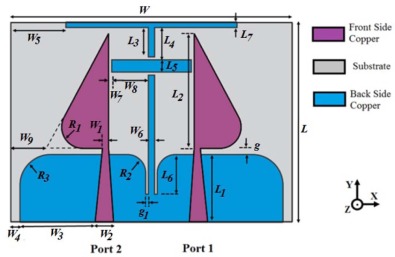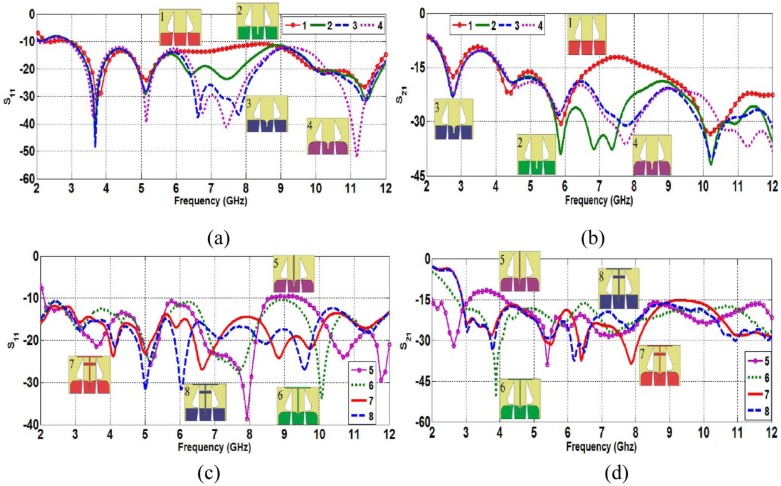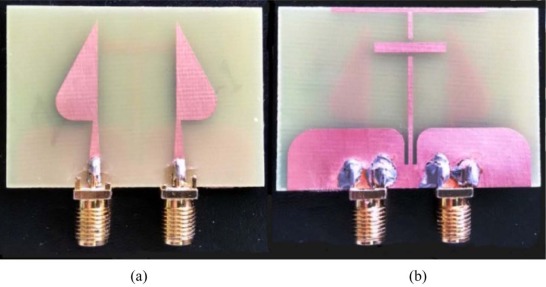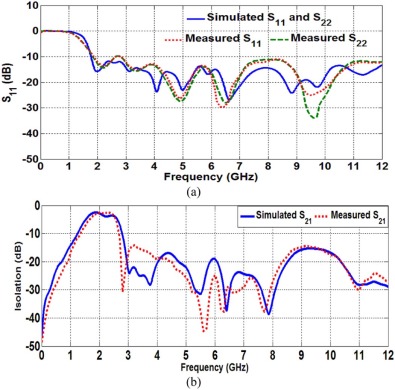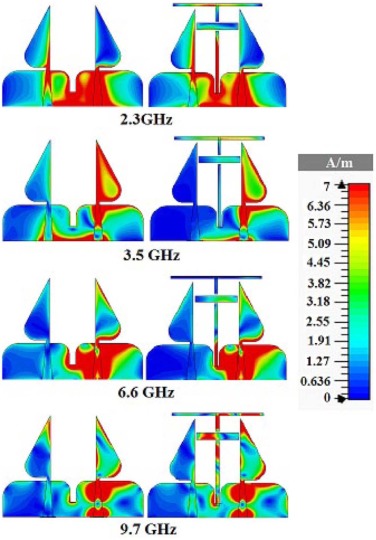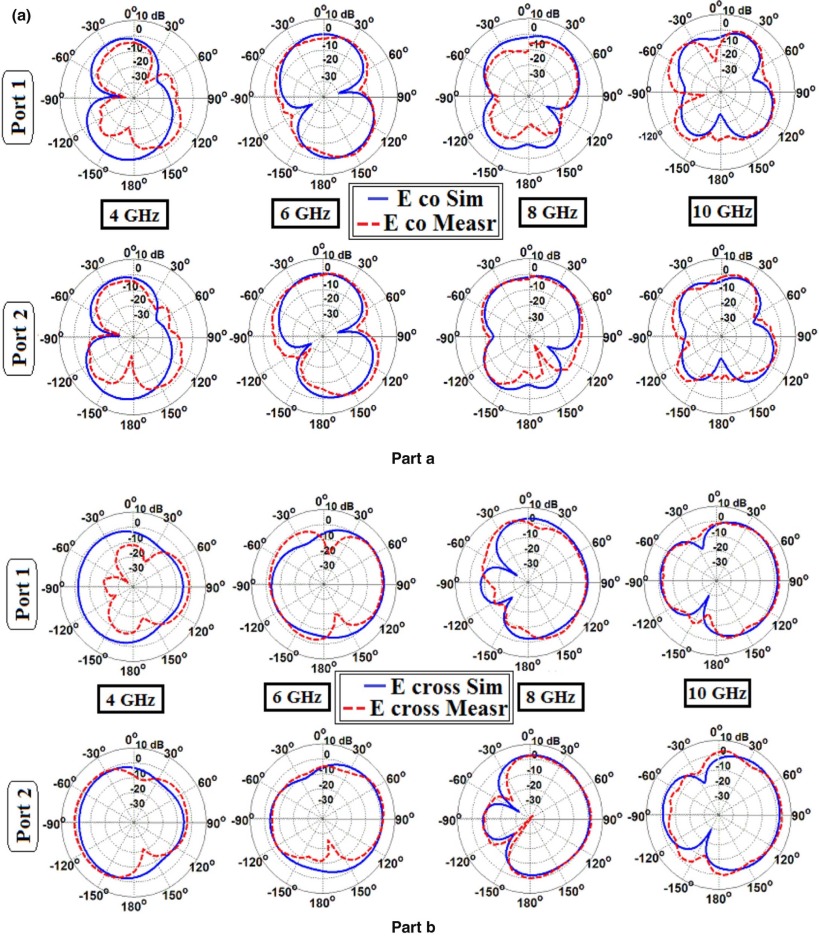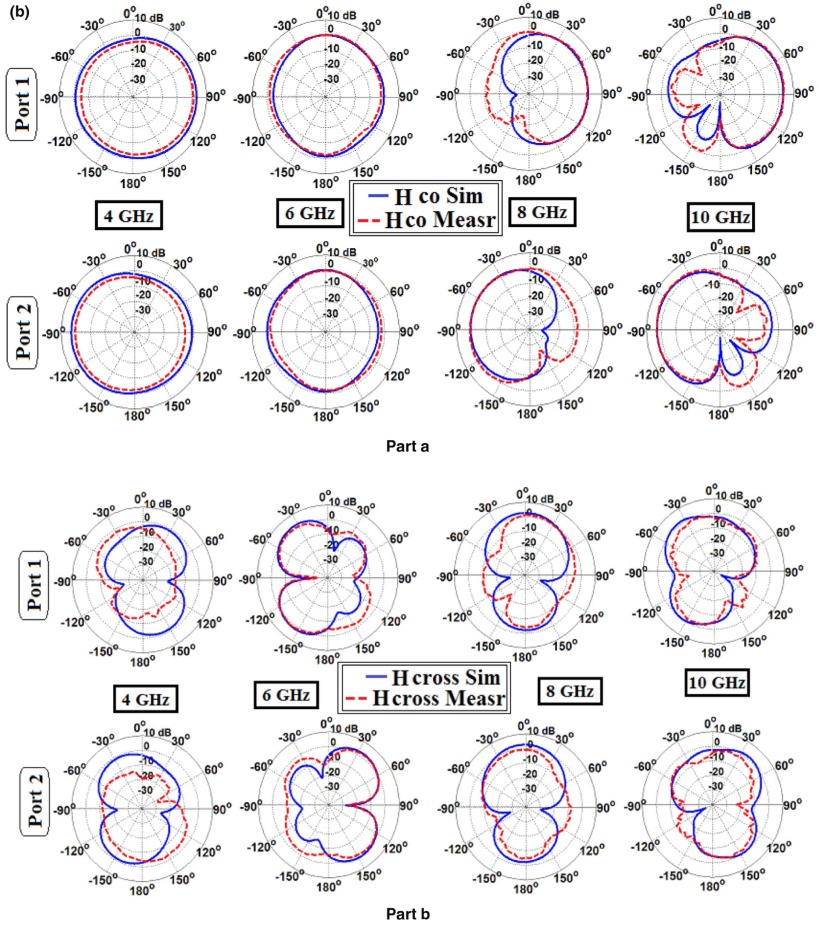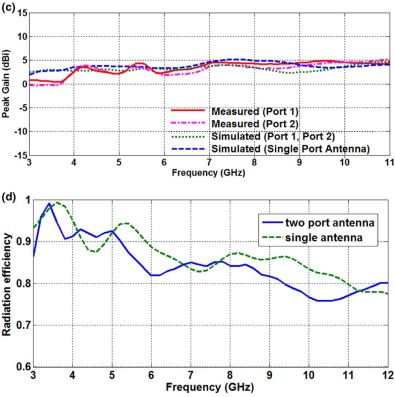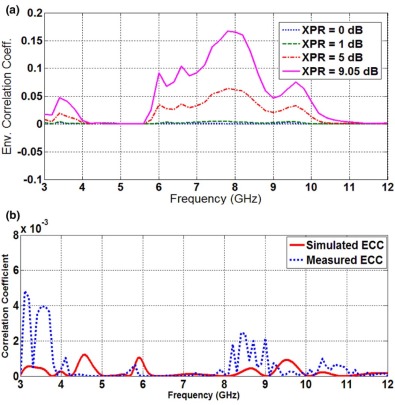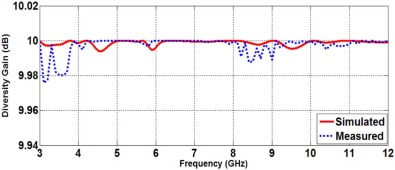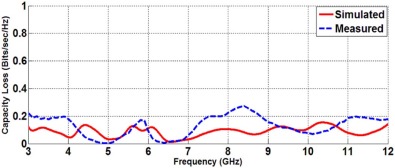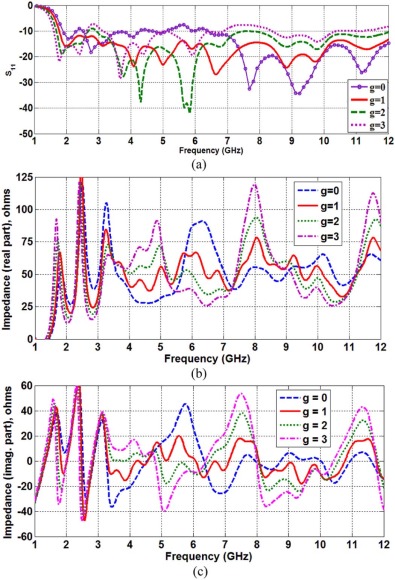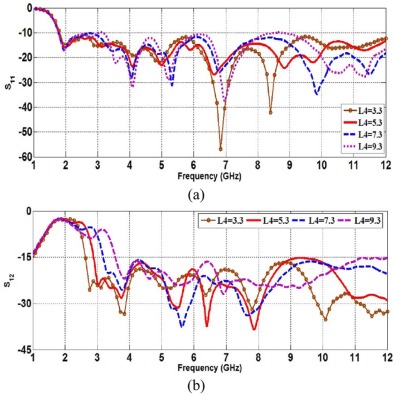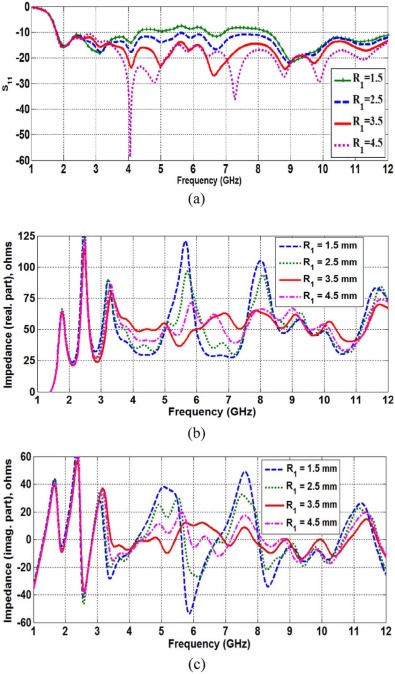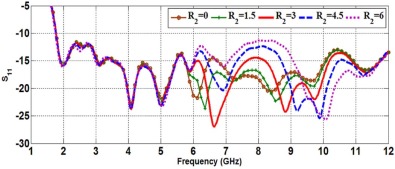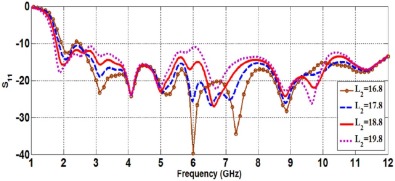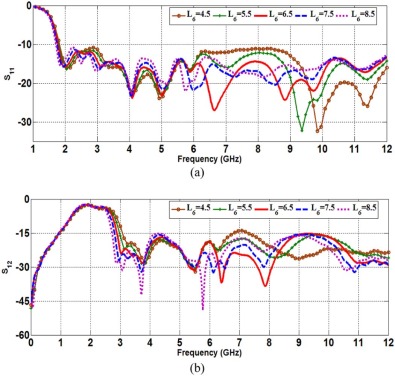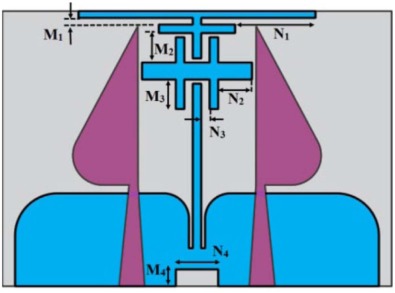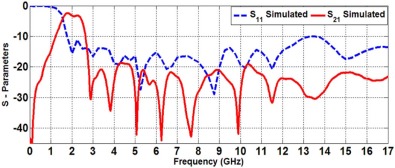Abstract
A compact, Ultra Wideband (UWB) antenna system for multi-input multi-output (MIMO)/diversity application is proposed. The antenna system is a microstrip structure with two similar triangular shaped radiating elements and a common ground plane. The radiating elements are excited by tapered feed for better impedance matching. A T-crossed shaped stub is added in the ground plane to increase the isolation between the two radiators. The overall dimension of the proposed antenna system is 46 mm × 32.6 mm × 1.6 mm. The measured impedance bandwidth (reflection coefficient < −10 dB) is from 1.8 GHz to well beyond 12 GHz which covers the entire UWB region. A measured isolation of 15 dB or better is achieved in the UWB region. The diversity gain of the antenna system is close to 10 dBi and the envelope correlation coefficient is well below 0.2 in the operating band. Parametric study is also done to check the sensitivity of the antenna in terms of reflection coefficient and isolation to the different parameters. These characteristics show that the proposed antenna is suitable for the MIMO/diversity application.
Keywords
Monopole antenna ; UWB antenna ; MIMO ; Channel fading ; Diversity of antenna
1. Introduction
Recently, a lot of efforts have been devoted to the emerging technology of Ultra Wideband due to advantages such as high data transfer rate, low power consumption, low cost and high capacity. The Federal Communications Commission (FCC) has authorised the unlicensed use of the 3.1–10.6 GHz spectrum for UWB applications [1] . Channel fading caused by multi-path environments is the main problem in a wireless communication system. Antenna diversity is an effective technique to mitigate channel fading and enhance transmission quality. Combining multiple antennas to achieve Multiple-Input Multiple-Output (MIMO) using UWB is a good way to achieve high data rate of about 1 GB/s. This technique takes the advantage of using multiple antennas at the transmitter and receiver terminal. A significant improvement in the wireless link can be achieved using spatial polarisation and pattern diversity techniques. The performance of the MIMO system depends on various parameters such as number of antenna elements, antenna geometry and spacing between these elements.
In the past many MIMO/diversity antenna systems have been designed and reported [2] , [3] , [4] , [5] , [6] , [7] , [8] , [9] and [10] . In [2] , two symmetric antennas are placed side by side with the overall dimension of 35 mm × 40 mm. This structure has impedance bandwidth from 3.1 GHz to 10.6 GHz using the treelike structure. The isolation is 16 dB within the operating band. In [3] , a UWB MIMO antenna using asymmetric coplanar fed structure is proposed. The antenna with overall size of 43.5 × 43.5 mm2 consists of stepped rectangular patch. The fence-type structure improves the operating bandwidth from 3.1 to 10.6 GHz and the isolation is found to be more than 15 dB. In [4] , a diversity antenna system of dimension 62 mm × 45 mm is proposed. The system consists of two square monopole antennas with working band of 3.3–10.4 GHz. A T-shaped stub is employed to get the isolation better than 18 dB. The antenna in [5] shows the pattern diversity and polarisation diversity and covers the lower UWB of 3.1–5.15 GHz. The isolation for this diversity antenna is better than 26 dB. In [6] , antenna system for pattern diversity is proposed having dimension of 80 mm × 80 mm. The antenna system has impedance bandwidth from 3 GHz to 12 GHz. To achieve the isolation better than 15 dB slant shorts are placed. In [7] , antenna system for polarisation diversity is proposed having dimension of 48 mm × 48 mm. The antenna system has impedance bandwidth from 2.3 GHz to 11 GHz and isolation better than 15 dB in the operating band. A MIMO antenna in [8] is proposed having dimension of 21 mm × 38 mm. The antenna consists of two quasi self complementary monopoles having a T-shaped ground plane. The impedance bandwidth of the antenna system is from 3.1 GHz to 10.6 GHz. Isolation of better than 15 dB in the operating band is achieved by placing two slots in the ground plane. A spatial diversity antenna having dimension of 48 mm × 115 mm is proposed in [9] by placing two monopoles orthogonally. The antenna operates between 2.3 GHz and 7.7 GHz with isolation better than 20 dB. In [10] , a 40 mm × 68 mm antenna system for MIMO application is designed. The antenna system has impedance bandwidth from 3.2 GHz to 10.6 GHz. The isolation of better than 15 dB is achieved by using Y-shaped stub. Most of the above discussed antennas have relatively larger size and also do not cover the lower Frequencies.
In this paper, a MIMO antenna system of compact size is designed and experimentally validated. The impedance bandwidth of the proposed antenna system is from 1.8 GHz to well beyond 12 GHz. A T-shaped stub in the ground plane is added to achieve isolation better than 15 dB in the operating band. A comparison of above discussed MIMO antenna system with the proposed antenna is given in Table 1 . From the table it can be seen that the proposed antenna has smaller size with lowest operating frequency.
| Sr. No. | Ref. No. | Electrical size (λ0 ) | Bandwidth (GHz) | Isolation (dB) |
|---|---|---|---|---|
| 1 | [2] | 0.36λ0 × 0.41λ0 | 3.1–10.6 | 16 |
| 2 | [3] | 0.45λ0 × 0.45λ0 | 3.1–10.6 | 15 |
| 3 | [4] | 0.68λ0 × 0.5λ0 | 3.3–10.4 | 18 |
| 4 | [5] | 0.26λ0 × 0.41λ0 | 3.1–5.15 | 26 |
| 5 | [6] | 0.8λ0 × 0.8λ0 | 3.0–12 | 15 |
| 6 | [7] | 0.37λ0 × 0.37λ0 | 2.3–11 | 15 |
| 7 | [8] | 0.21λ0 × 0.39λ0 | 3.1–10.6 | 15 |
| 8 | [9] | 0.37λ0 × 0.88λ0 | 2.3–7.7 | 20 |
| 9 | [10] | 0.43λ0 × 0.73λ0 | 3.2–10.6 | 15 |
| Proposed | 0.29λ0 × 0.21λ0 | 1.9 – 16.7 | 15 | |
| Modified | 0.29λ0 × 0.21λ0 | 1.9 – 16.7 | 20 | |
2. Antenna geometry
The antenna geometry with Cartesian co-ordinate system is shown in Fig. 1 . The antenna is printed on the FR-4 substrate with dielectric constant of 4.4 with thickness 1.6 mm and loss tangent 0.02. The antenna system consists of two microstrip fed similar triangular radiating patches. The two triangular radiating patches are symmetrically positioned with respect to y-axis and are separated by 14 mm. The radiating patches are fed by tapered microstrip lines for better impedance matching. Lower corners of the radiating patch are blended for increasing the current in the patch, i.e. to improve the return loss in the working frequency band especially in the mid frequency range. Separation between the ground and the radiating patch is optimised for the maximum impedance matching. To improve the isolation between the two radiating patches a narrow slot is etched in the ground plane and an additional T-shaped stub is added. This T-shaped stub works as a reflector and hence it reduces the mutual coupling between the two radiating patches. Finally the antenna dimensions are optimised for maximum impedance matching and isolation. The optimised dimensions are given in Table 2 .
|
|
|
Fig. 1. Diagram of antenna geometry. |
| Parameter | L | L1 | L2 | L3 | L4 | L5 | L6 | L7 |
|---|---|---|---|---|---|---|---|---|
| Value (mm) | 32.6 | 11 | 18.8 | 4.8 | 5.3 | 2 | 6.5 | 0.8 |
| Parameter | R1 | R2 | R3 | W | W1 | W2 | W3 | W4 |
| Value (mm) | 3.5 | 3 | 5 | 46 | 1 | 3 | 12.3 | 1.5 |
| Parameter | W5 | W6 | W7 | W8 | W9 | g | g1 | |
| Value (mm) | 9 | 1 | 0.5 | 6 | 6 | 1 | 0.45 |
3. Evolution of the antenna
The two antennas share a common ground plane shown in Fig. 1 . Fig. 2 shows the improvement in the return loss and isolation achieved through step-by-step ground changes. In Fig. 2 a, graph-1 is for the antenna with the linear ground plane and has return loss of about 10 dB at all the frequencies.
|
|
|
Fig. 2. Simulated reflection coefficient and isolation of stepwise evolution of antenna: (a) |S11 |, (b) |S12 |, (c) |S11 |, (d) |S12 |. |
The major improvement in the return loss at higher frequencies is accomplished due to the cut in the ground plane, blending the inner edges of the cut in the ground and by blending the outer edges of the ground plane. As shown in Fig. 2a and b , graph-4 shows the best results for the return loss as well as for the isolation. The working band with a 12 dB return loss starts from 3 GHz and goes beyond 12 GHz, the isolation is better than 15 dB from 4 GHz. To improve the isolation over the entire working band, a T shaped reflector is added in the ground. The ground with cuts and blended edges is modified by adding this vertical strip, due to which the return loss at 9 GHz just touches the −10 dB line and isolation is 15 dB excluding the range of 3 GHz–4.1 GHz. A horizontal line is added at the top of the reflector to make it T shaped; this improves the isolation in the lower frequency band. Finally, a second horizontal line is added in the T shaped stub and it improves the return loss (graph-8) shown in Fig. 2c .
The dimensions of the antenna are chosen to have the first (or the fundamental) resonance near 3.5 GHz so that the operating band starts from 3.1 GHz. In case of the return loss characteristic of the final stage in Fig. 2c , the resonance seen at 4 GHz is due to the triangular radiating patch acting like a monopole. The resonance frequency of a monopole is given by
|
|
where c is the velocity of light in free space and h is the monopole height. For the proposed antenna, from Fig. 1 , h = L2 + g which is equal to 19.8 mm from the dimensions given in Table 2 . Using this value of h , the resonance frequency is calculated to be 3.78 GHz which matches well with the simulated resonance near 4 GHz. The resonances seen at higher frequencies are the harmonics of the fundamental resonances while the resonance seen near 2 GHz (in Fig. 2c and in Fig. 3a ) is due to the extended ground plane. A merging of all these resonances gives the ultra wideband characteristics of the antenna.
4. Results and discussion
The antenna system is fabricated with the optimised dimensions. An R&S vector network analyser ZVA 40 is used to measure the reflection coefficients and isolation of the proposed antenna. The front and back views of the fabricated prototype are shown in Fig. 3 . Fig. 4a shows reflection coefficients of the two ports of the antenna system. From the figure it can be seen that the measured impedance bandwidth is from 1.8 GHz to 16.7 GHz for both the ports. The measured and simulated results are in fair agreement. The slight difference between the measured and simulated results may be due to fabrication tolerances, impurity in substrate and low quality of SMA connector. Fig. 4b shows the isolation between the two ports. From the figure it can be seen that an isolation more than 15 dB is achieved in the UWB starting from 2.8 GHz. Again the measured and simulated results are in good agreement.
|
|
|
Fig. 3. Photograph of proposed UWB MIMO/Diversity antenna system: (a) front view, (b) back view. |
|
|
|
Fig. 4. Simulated and measured results of antenna: (a) return loss, (b) isolation. |
5. Current distribution
Fig. 5 shows the current distribution at arbitrarily selected frequencies of 2.3 GHz, 3.5 GHz, 6.6 GHz and 9.7 GHz for the port-1 of the proposed antenna. As both the antennas are similar in geometry, current distribution for only port 1 is shown. The figure shows the current distribution for the antenna without the T shaped stub and with the stub, to verify the importance of adding the reflecting stub in order to improve the performance of the antenna. Further, from the figure it is apparent that without the stub, current transfers from port-1 to port-2 which is then absorbed by the reflecting stub. It is seen that the major effect of the stub is at the lower frequency as observed at 3.5 GHz. The reflector mainly improves the isolation at lower frequencies and is also seen in Fig. 2d using the scattering parameters.
|
|
|
Fig. 5. Current distribution of antenna for Port-1 at (a) 2.3 GHz, (b) 3.5 GHz, (c) 6.6 GHz, (d) 9.7 GHz. |
6. Radiation patterns
The measured and simulated radiation patterns for the proposed two port diversity antenna are shown in Fig. 6 . The radiation patterns for port-1 and port-2 at four different frequencies of 4 GHz, 6 GHz, 8 GHz and 10 GHz are shown and are relatively consistent in the UWB. Due to the symmetric nature of the two antennas, the radiation patterns for the two ports are similar in the E (y-z) plane while the radiation patterns in the H(x-z) plane are mirror images; such behaviour is useful for pattern diversity. The E plane shows the figure of eight like structure, whereas the H plane shows the omni-directional nature.
Fig. 6.
(a) Measured and simulated E-plane co- and cross radiation patterns of port 1 and port 2. (b) Measured and simulated H-plane co- and cross radiation patterns of port 1 and port 2. (c) Peak gain comparison of the two port antenna and the single antenna. (d) Radiation efficiency comparison of the two port antenna and single antenna.
The simulated and measured peak gains and simulated radiation efficiency of the antenna are plotted in Fig. 6c and d . In the figure, the simulated gain and radiation efficiency of a single antenna is also plotted for comparison purpose. It can be seen that gain for both the cases is almost the same except near 9 GHz where the gain of the single antenna is slightly lesser. The efficiency of the two port antenna is slightly less than the efficiency of the single port antenna which may be due to increased conductor losses in the extended ground plane.
7. Diversity parameters
7.1. Envelope correlation coefficient
The diversity performance of an antenna can be obtained by calculating the envelope correlation coefficient. When an antenna is used for diversity applications, the signals received at the two ports should not be correlated with each other, otherwise there will be interference and cross-talk. The envelope correlation coefficient measures this correlation between the signals at the two ports and shows how the two communication channels are isolated from each other. It is denoted by ρe . It can be calculated from the far-field radiation patterns using Eq. (1)[11] . It should be less than 0.5 for good diversity performance [12] .
|
|
( 1) |
In Eq. (1) , XPR is the environment dependent cross polarisation ratio, Gθ, Gϕ are the power gain patterns and Pθ, Pϕ are the components of angular density functions of the incident power wave. The simulated envelope correlation coefficients are shown in Fig. 7a . In the simulation, four different environments are considered: the uniform environment for which XPR = 0 dB, the indoor environment for which XPR = 1 dB, the outdoor environment for which XPR = 5 dB and the WINNER (Wireless World Initiative New Radio) environment for which XPR = 9.05 dB [11] . For all the cases, the ECC is less than 0.2 as desired.
|
|
|
Fig. 7. (a) Simulated envelope correlation coefficient using radiation patterns. (b) Simulated and measured envelope correlation coefficient using S-parameters. |
For a uniform environment, the ECC can also be calculated from the S-parameters using Eq. (2)[13] . The simulated and measured ECC using the S-parameters is shown in Fig. 7b and both are below 0.004.
|
|
( 2) |
The method of calculating the envelope correlation coefficient from the S-parameters cannot be used when the environment is non-uniform. In such cases, only the radiation patterns can be used to calculate ρe . However, the S-parameter method is far easier to implement and gives reasonably accurate results and is hence preferred more.
7.2. Diversity gain
The gain of an antenna gives the ratio of the intensity in a given direction to the isotropically radiated intensity. High gain gives a directional radiation pattern. Diversity gain (dB) gives the amount of the reduced transmitted power when the diversity scheme is used. The envelope correlation coefficient is the affecting factor for the diversity gain as given in Eq. (3) ,
|
|
( 3) |
Fig. 8 shows the comparison of simulated and measured diversity gains. The diversity gain is above 9.98 dB, with little variations gain seen in the graph. Higher diversity gain is due to the higher antenna efficiency which shows lower mutual coupling between the antennas. As seen from Fig. 7 and Fig. 8 , the variation in the diversity gain corresponds to the variation in the correlation coefficient.
|
|
|
Fig. 8. Measured and simulated diversity gains. |
7.3. Capacity loss
Along with the correlation coefficient and diversity gain, capacity loss is another parameter to describe the diversity performance of a MIMO antenna. The formula shown in Eq. (4) gives the capacity loss using the S-parameters |S11 |, |S22 |, |S12 | and |S21 |. The amount of performance degradation of the system is given by capacity loss [14] .
|
|
( 4) |
where and
|
|
Fig. 9 shows the simulated and measured capacity loss. The measured capacity loss is below 0.3 bps/Hz, which is quite relevant to the simulated results. From Fig. 6 and Fig. 9 , good performance of the MIMO antenna can be expected with less mutual coupling and low values of the Envelope correlation coefficient and the capacity loss.
|
|
|
Fig. 9. Simulated and measured capacity loss. |
8. Parametric study
8.1. Variation of the gap between patch and ground ‘g’
The spacing between the ground and the patch which are on opposite sides of the substrate is an important factor in the antenna design to obtain the 50 Ω impedance. As the gap g decreases, the return loss (|S11 |) increases within the frequency range of 3.5 GHz–7 GHz, whereas increase in g decreases the |S11 | at 3 GHz and at high frequency band from 6 GHz (Fig. 10 ). Isolation is not much affected by the spacing between the ground and patch and hence not shown. The effect of the gap on the real and imaginary parts of the antenna impedance is shown in Fig. 10b and c . For the smallest gap, near 6 GHz, the imaginary part is positive where the real part has also a higher value. Over most of the other frequencies for this gap, the real part is less than or close to 50 ohms while the imaginary part is negative. As the gap is optimised, the real part moves closer to 50 ohms while the imaginary part moves closer to 0 ohms.
|
|
|
Fig. 10. Effect of spacing g (in mm) between patch and ground on (a) |S11 |, (b) real part of impedance and (c) imaginary part of impedance. |
8.2. Variation in spacing L4
The position of the horizontal strip in between the T shaped reflector from the top of antenna is given by the parameter (L4 + L7 ). Keeping L7 constant and varying L4 , this strip shifted down nearer to the ground. This decreases the return loss in mid frequency range and the bandwidth of the isolation is decreased. The graph shown by the continuous line for L4 = 5.3 mm in Fig. 11 is the best one for the proposed antenna, where the return loss is better than −13 dB and isolation well below −15 dB.
|
|
|
Fig. 11. Effect of L4 (in mm) on (a) return loss |S11 |, (b) isolation |S12 |. |
The equilateral triangle is divided into two parts by splitting it vertically. But it is very difficult to match the impedance of the feed line and the triangular patch. So to improve the impedance matching and in turn the return loss, the lower corner of the triangular patch is made round using the blending of radius of R1 = 3.5. Blending up to 3.5 improves the return loss from 3.5 GHz (Fig. 12 ). Further increase in the blend distorts the return loss at lower frequencies. The effect of the blend R1 on the real and imaginary parts of the antenna impedance is shown in Fig. 12b and c . Over 3–5 GHz and 6–8 GHz, the real and imaginary parts increase with the blend while over 5–6 GHz, they decrease with the blend. As the blend is optimised, the real part moves closer to 50 ohms while the imaginary part moves closer to 0 ohms.
|
|
|
Fig. 12. Effect of blend of patch R1 (in mm) on (a) return loss |S11 |, (b) real part of impedance and (c) imaginary part of impedance. |
8.3. Variation in blend R2
The notches are made in the ground on the lateral side of the T shaped stub to improve the return loss |S11 |. The upper corners of the notches are blended to make them round, blending it with R2 = 3 mm gives better return loss as shown in Fig. 13 . Blending up to 3 mm does not affect the return loss, but over blending distorts the return loss over the higher frequency band.
|
|
|
Fig. 13. Effect of R2 (in mm) on return loss |S11 |. |
8.4. Variation in patch height L2
The height of the triangular patch is shown by length L2 . The height of the antenna is inversely proportional to the resonant frequency of operation. From Fig. 14 given below increasing the height of the antenna from 18.8 to 19.8 is seen to reduce the return loss and the bandwidth of operation while reducing the height of antenna, i.e. L2 increases the B.W.
|
|
|
Fig. 14. Effect of patch height L2 (in mm) on return loss. |
8.5. L6 variation
The two notches in the ground plane covering the base of T shaped stub have dimension g1 × L6 . The return loss is directly proportional to the length of notch L6 ; decrease in L6 decreases the return loss as shown in Fig. 15 . But increasing the L6 beyond the proposed value up to 8.5 mm does not affect |S11 | whereas |S12 | distorts around 4.2 GHz.
9. Modified antenna
The proposed antenna shown in Fig. 1 is modified by adding the Π like structure in the stub and a rectangular slot in the ground. The improved version of the antenna is shown in Fig. 16 . The modified dimensions of the antenna are shown in Table 3 . The newly added two vertical lines and one horizontal line to form the Π like structure and the slot in the ground increase the isolation. The isolation of the antenna shown in Fig. 3 is better than 15 dB which is further improved to 20 dB as shown in Fig. 17 .
|
|
|
Fig. 15. Effect of length L6 (in mm) on (a) |S11 |, (b) |S12 |. |
|
|
|
Fig. 16. Antenna geometry for results improvement. |
| Parameter | M1 | M2 | M3 | M4 |
|---|---|---|---|---|
| Value (mm) | 0.8 | 3.5 | 3 | 2 |
| Parameter | N1 | N2 | N3 | N4 |
| Value (mm) | 9.5 | 4 | 1 | 5 |
|
|
|
Fig. 17. Improved simulated return loss and isolation of modified antenna. |
10. Conclusions
A compact planar UWB MIMO/Diversity antenna has been investigated in this paper. The measured impedance bandwidth for |S11 | < −10 dB varies from 1.8 GHz to beyond 12 GHz, which satisfy the requirements for UWB. The isolation of 17 dB is obtained from 2.9 GHz to 12 GHz and above. The step-by-step change in the antenna geometry for improvement of results is shown. Radiation pattern gives omnidirectional behaviour in the H plane and bidirectional behaviour in the E plane. In the H-plane, the radiation patterns for both the antennas are complimentary to each other. A modified antenna with improved isolation is also presented. Envelope correlation coefficient is less than 0.2 for non uniform environment and diversity gain is approximately close to 10 dB. These results show that the proposed antenna system is suitable for portable MIMO/Diversity applications.
Acknowledgement
The second author is an M. Tech. student at DIAT (Deemed University), Pune, India and acknowledges the financial support of DIAT (DU) , Pune as fellowship during his M. Tech. course.
References
- [1] Federal Communications Commission; First report and order; April (2002)
- [2] S. Zhang, Z. Ying, J. Xiong, S. He; Ultrawideband MIMO/diversity antennas with a tree-like structure to enhance wideband isolation; IEEE Antenn. Wirel. Propag. Lett, 8 (2009), pp. 1279–1282
- [3] H. Qin, Y. Liu; Compact UWB MIMO antenna with ACS-Fed structure; Prog. Electromag. Res. C, 50 (2014), pp. 29–37
- [4] Y. Cheng, W. Lu, C. Cheng, W. Cao, Y. Li; Compact diversity antenna with T shaped stub for ultra-wideband applications; Microwave Conference, APMC, Asia-Pacific (2008)
- [5] S. Zhang, B. Lau, S. He; Closely-packed UWB MIMO/diversity antenna with different patterns and polarizations for USB dongle applications; IEEE Trans. Antenn. Propag, 60 (9) (2012)
- [6] M. Gallo, E. Daviu, M. Bataller, M. Bozzetti, J. Pardo, L. Llacer; A broadband pattern diversity annular slot antenna; IEEE Trans. Antenn. Propag, 60 (3) (2012), pp. 1596–1600
- [7] H. Huang, Y. Liu, S. Zhang, S. Gong; Uniplanar ultrawideband polarization diversity antenna with dual band-notched characteristics; IEEE Antenn. Wirel. Propag. Lett, 13 (2014)
- [8] L. Liu, S. Cheung, T. Yuk; Compact multiple-input–multiple-output antenna using quasi-self- complementary antenna structures for ultrawideband applications; IET Microw. Antenn. Propag, 8 (13) (2014), pp. 1021–1029
- [9] K. Wong, S. Su, Y. Kuo; A printed ultra-wideband diversity monopole antenna; Microw. Opt. Technol. Lett, 38 (4) (2003), pp. 257–259
- [10] A. Najam, Y. Duroc, S. Tedjni; UWB-MIMO antenna with novel stub structure; Prog. Electromag. Res. C, 19 (2011), pp. 245–257
- [11] M. Karaboikis, V. Papamichael, G. Tsachtsiris, C. Soras, V. Makios; Integrating compact printed antennas onto small diversity/MIMO terminals; IEEE Trans. Antenn. Propag, 56 (7) (2008), pp. 2067–2078
- [12] S. Kharche, G.S. Reddy, B. Mukherjee, R. Gupta, J. Mukherjee; MIMO antenna for bluetooth, Wi-Fi, Wi-MAX and UWB applications; Prog. Electromag. Res. C, 52 (2014), pp. 53–62
- [13] C. Votis, G. Tatsis, P. Kostarakis; Envelope correlation parameter measurements in a MIMO antenna array configuration; Int. J. Commun. Netw. Syst. Sci, 3 (4) (2010), pp. 350–354
- [14] C. See, R.A. Abd-Alhameed, Z.Z. Abidin, N.J. McEwan, P.S. Excell; Wideband printed MIMO/Diversity monopole antenna for WiFi/WiMAX applications; IEEE Antenn. Wirel. Propag. Lett, 60 (4) (2012)
Document information
Published on 10/04/17
Licence: Other
Share this document
Keywords
claim authorship
Are you one of the authors of this document?
